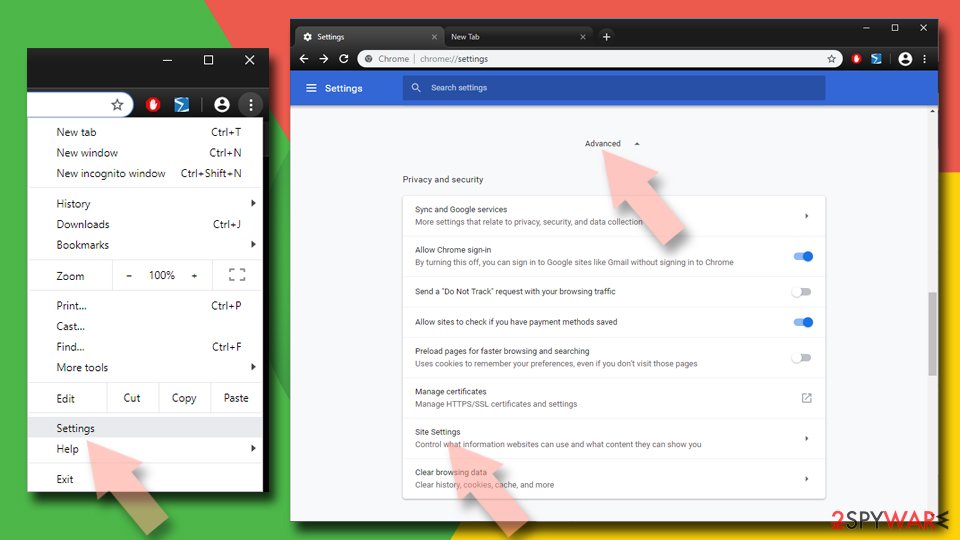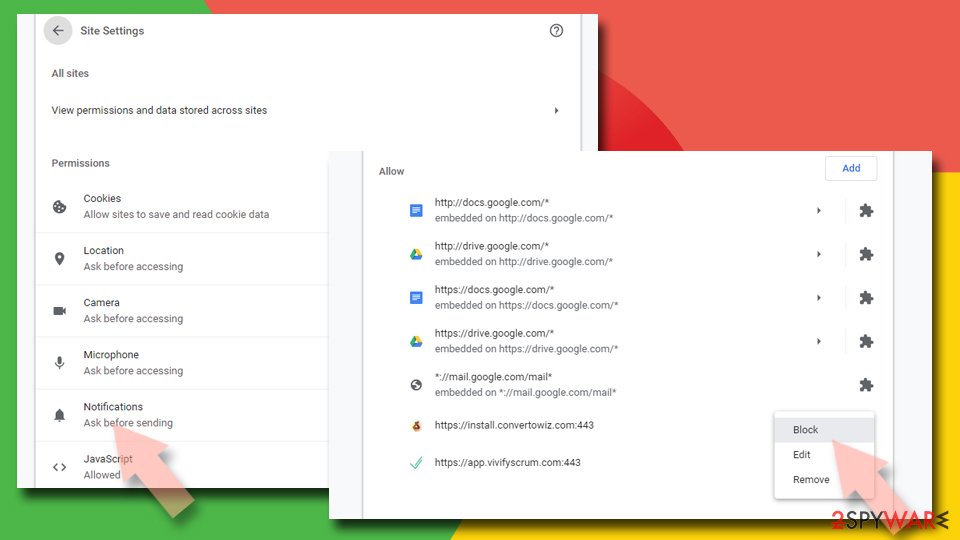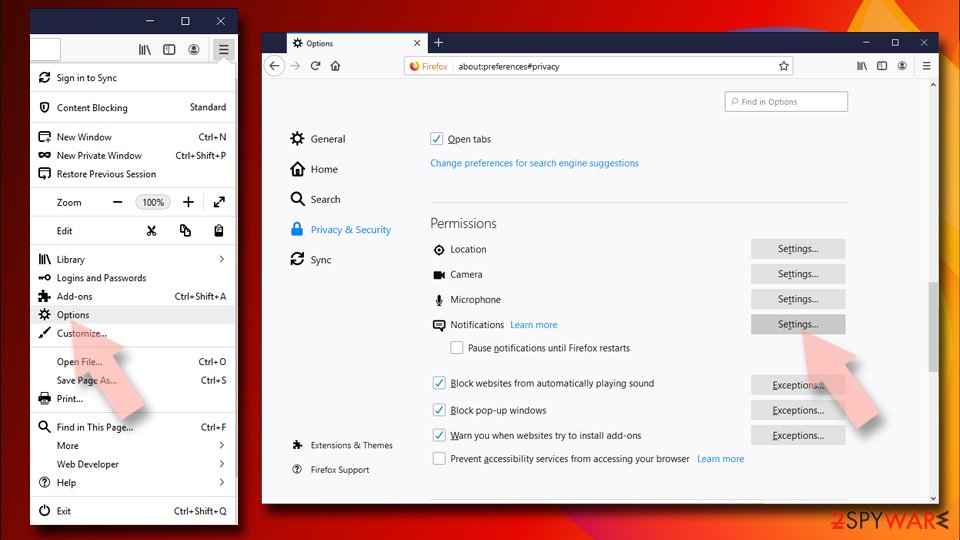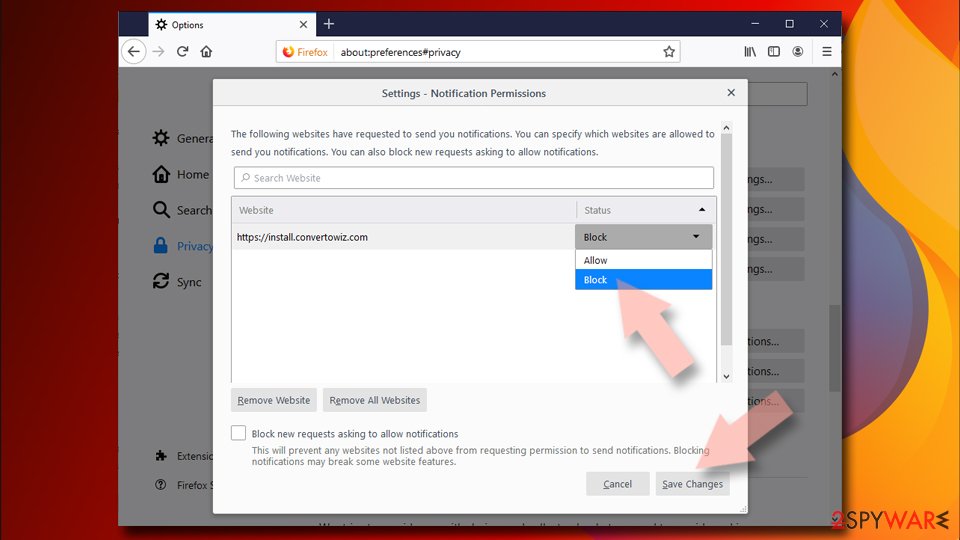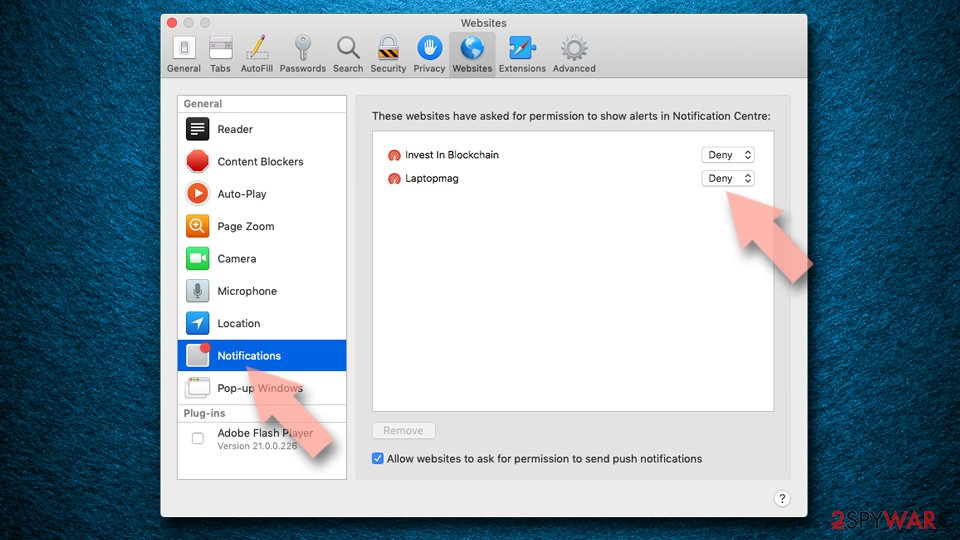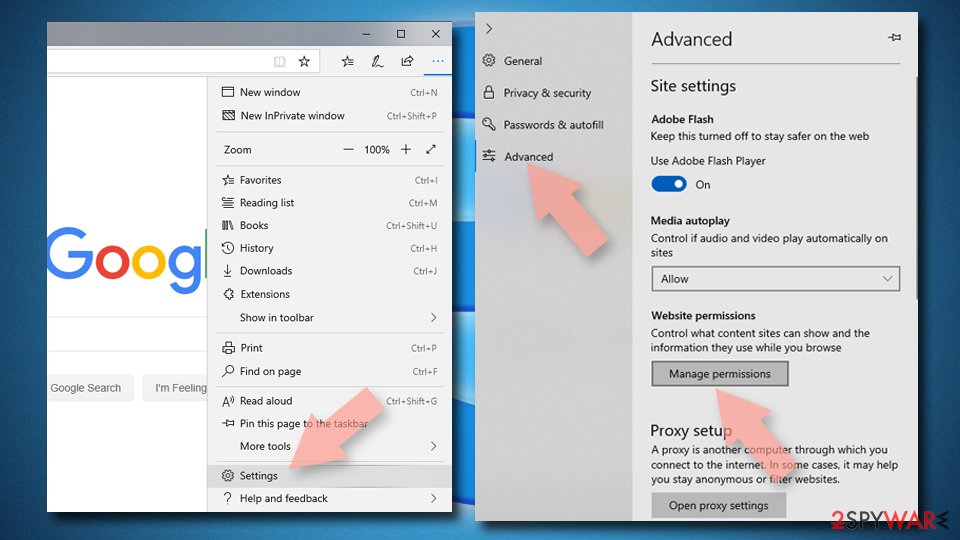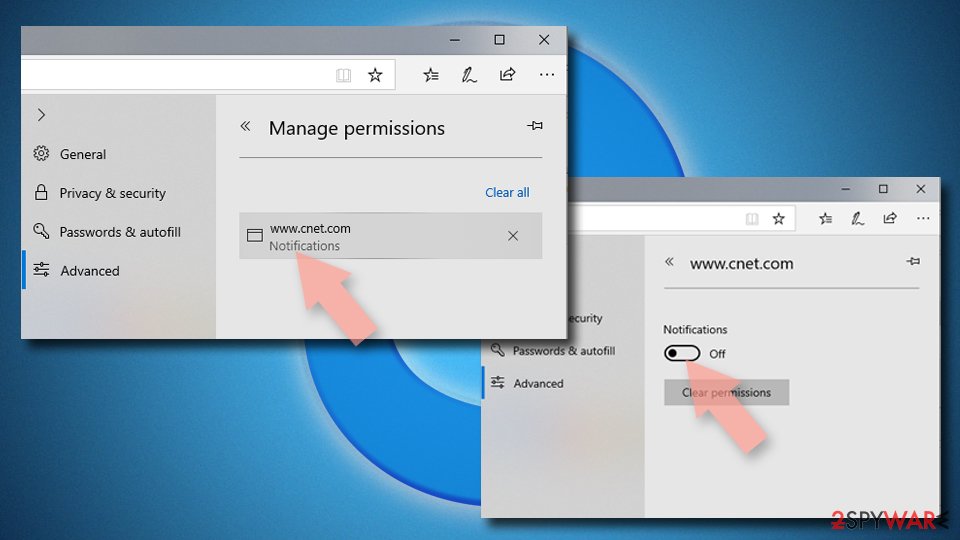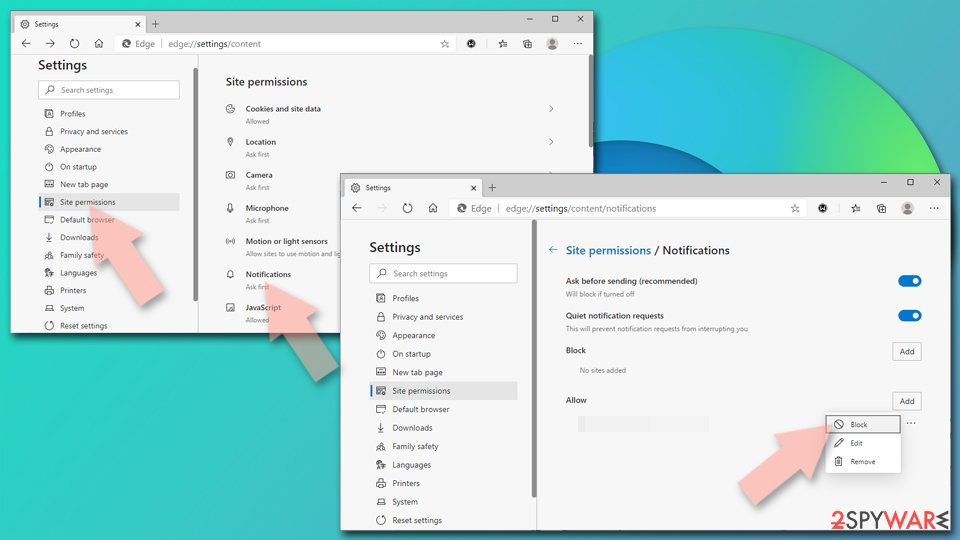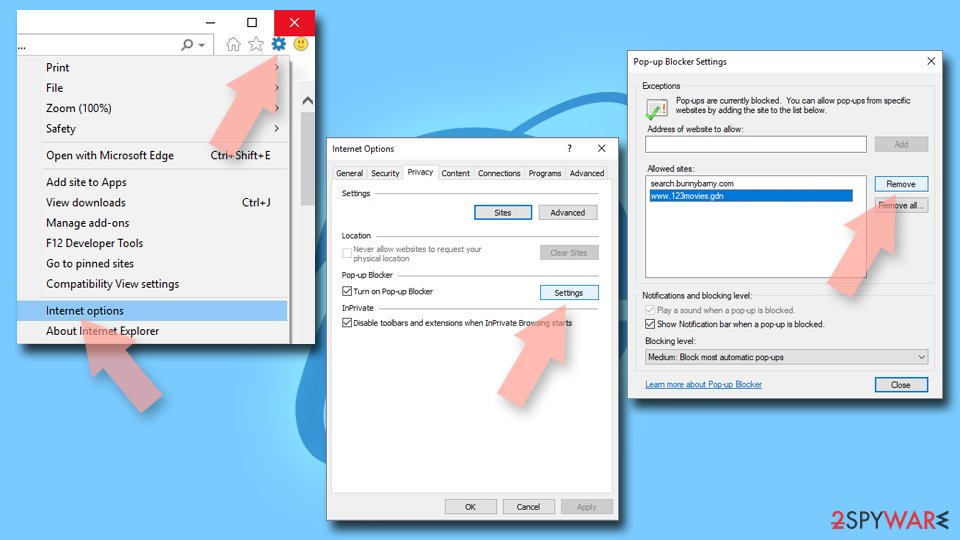Bluewinds.xyz pop-up ads (fake) - Chrome, Firefox, IE, Edge
Bluewinds.xyz pop-up ads Removal Guide
What is Bluewinds.xyz pop-up ads?
Bluewinds.xyz ads can disrupt your online activities and bring you to dangerous websites

You might encounter Bluewinds.xyz website after being redirected from somewhere else via your browser – be it Google Chrome, Mozilla Firefox, MS Edge, or another. Upon entry, you will be presented with a pop-up message that asks you to enable notifications. Additionally, you might see a deceptive picture in the background with misleading information, which is supposed to convince you that pressing the “Allow” button is the right thing to do.
If you fulfill the request, you automatically grant the website to deliver your notifications, delivered periodically at random times. These commonly include links to potentially dangerous websites. If clicked, you might be tricked into subscribing to more notifications from insecure sites, install useless or malicious software, or provide your personal information to scammers.
This is why you should never click on the links provided and instead of the notifications once and for all. For that, you need to access web browser settings and deny permission for Bluewinds.xyz ads to be shown. Below you will find more information about the scam, how to avoid it in the future, and how to make the pesky notifications go away for a safer system.
| Name | Bluewinds.xyz |
|---|---|
| Type | Push notifications, scam, ads |
| Distribution | Notifications begin to show up soon after the “Allow” button within the site is pressed |
| Symptoms | Pop-ups show up at the bottom-left corner of the screen at any time |
| Dangers | Clicking on links that are embedded within the notification prompt, exploring the sites these links bring to or downloading files can be particularly dangerous – you might get infected with malware, suffer from financial losses or privacy issues |
| Elimination | To prevent the site from displaying notifications to you, access the site permission section via your web browser settings – you can find more details below |
| Further steps | Redirects and ads might indicate adware infection, so you should check your system with security software, clean your browsers, and attempt to fix virus damage with a repair tool FortectIntego |
This is why you end up on potentially dangerous websites
There are two ways how you could have ended up on a scam website on the internet:
- You clicked on a link on a malicious website
- You were redirected by adware[1] installed on your computer.
Billions of websites exist on the internet, and tech giants such as Google made a lot of progress regarding the safety of the content provided within those sites. Nonetheless, scams are relatively difficult to detect, as they need first to be reported. As soon as that is done, these websites are shut down for good by service providers.
Thus, it is inevitable that you might come across a suspicious or malicious website once in a while, so you should always take precautionary measures. For example, employing powerful security software with real-time protection can warn you about the incoming dangers. Also, using an ad-blocker can prevent you from viewing malicious ads.
When it comes to adware, however, it might act more unpredictable. Some more aggressive types might open browser windows at any time and direct you to ad-filled or malware-laden pages. Less aggressive adware might be difficult to spot, as ads and redirects might be less common.
Nonetheless, adware is usually distributed within software bundles, which often results in users not being aware that they have their computers infected in the first place. This is why we strongly recommend you employ SpyHunter 5Combo Cleaner, Malwarebytes, or another anti-malware software and perform a full system scan to ensure that no malicious programs are hiding on your device.
If adware of malware was indeed found, we also recommend you use FortectIntego to clean your web browsers and repair damaged system files. You can also reset your web browsers if required. If you need more details about performing these steps on various browsers, check the instructions at the bottom section of this article.

Remove the unwanted notifications
Scams and deception can sometimes be difficult to recognize, especially for those less tech-savvy. Cybercriminals are well aware of that; that's why scams like You've made the 9.68-billionth search, Pornographic virus alert from Microsoft, Your system is infected with (3) viruses, and many others, exist. They prey on users who are easily manipulated, all in exchange for monetary gain. This disgusting behavior won't stop any time soon; hence spreading awareness is so important.
When it comes to the creators of Bluewinds.xyz, they are trying to use various social engineering[2] techniques in order to make users subscribe to the notifications. These can then be used to deliver ads directly on users' screens. If clicked, intentionally or not, these ads benefit the crooks financially.
Obviously, users will not subscribe to such ads intentionally, so the creators need to think of something that would convince them to do so. Usually, they ask users to subscribe by pretending that the action itself means something else. One of the examples you might encounter could say the following:
Click “Allow” to close this window
Some users might believe that clicking the button would actually be a way to get out of the site – it is obviously not true. In other cases, crooks imply that some video is about to be shown, or a user must verify that they are not a robot. In any case, the result is always the same – visitors are then redirected to a similar website, or the page is refreshed. The difference is, however, that the notifications can now be produced at any time and will be shown directly on the desktop.
If that happened to you, don't worry. All you have to do is prevent the website from sending you ads. Follow these steps:
Google Chrome (desktop):
- Open Google Chrome browser and go to Menu > Settings.
- Scroll down and click on Advanced.
- Locate Privacy and security section and pick Site Settings > Notifications.
![Stop notifications on Chrome PC 1 Stop notifications on Chrome PC 1]()
- Look at the Allow section and look for a suspicious URL.
- Click the three vertical dots next to it and pick Block. This should remove unwanted notifications from Google Chrome.
![Stop notifications on Chrome PC 2 Stop notifications on Chrome PC 2]()
Mozilla Firefox:
- Open Mozilla Firefox and go to Menu > Options.
- Click on Privacy & Security section.
- Under Permissions, you should be able to see Notifications. Click Settings button next to it.
![Stop notifications on Mozilla Firefox 1 Stop notifications on Mozilla Firefox 1]()
- In the Settings – Notification Permissions window, click on the drop-down menu by the URL in question.
- Select Block and then click on Save Changes. This should remove unwanted notifications from Mozilla Firefox.
![Stop notifications on Mozilla Firefox 2 Stop notifications on Mozilla Firefox 2]()
Safari:
- Click on Safari > Preferences…
- Go to Websites tab and, under General, select Notifications.
- Select the web address in question, click the drop-down menu and select Deny.
![Stop notifications on Safari Stop notifications on Safari]()
MS Edge:
- Open Microsoft Edge, and click the Settings and more button (three horizontal dots) at the top-right of the window.
- Select Settings and then go to Advanced.
- Under Website permissions, pick Manage permissions and select the URL in question.
![Stop notifications on Edge 1 Stop notifications on Edge 1]()
- Toggle the switch to the left to turn notifications off on Microsoft Edge.
![Stop notifications on Edge 2 Stop notifications on Edge 2]()
MS Edge (Chromium):
- Open Microsoft Edge, and go to Settings.
- Select Site permissions.
- Go to Notifications on the right.
- Under Allow, you will find the unwanted entry.
- Click on More actions and select Block.
![Stop notifications on Edge Chromium Stop notifications on Edge Chromium]()
Internet Explorer:
- Open Internet Explorer, and click on the Gear icon at the top-right on the window.
- Select Internet options and go to Privacy tab.
- In the Pop-up Blocker section, click on Settings.
- Locate web address in question under Allowed sites and pick Remove.
![Stop notifications on Internet Explorer Stop notifications on Internet Explorer]()
You can get rid of notification prompts via browser settings
Initially, the browser notification feature is not malicious and intended for good use. In fact, most legitimate websites might ask you to show you notifications, and you are free to decline that. That being said, many users said that they are simply annoyed by these prompts in the first place, as it is just another stop that needs to be done to enjoy the actual content of the site.
If you are one of such people and would like to disable notification prompts so you wouldn't have to click “Block” each time, there is a solution for you. Follow these steps:
- Open Google Chrome
- Go to Menu > Settings
- Scroll down to Privacy and security section
- Select Site Settings
- Scroll down again and pick Notifications
- Choose Use quieter messaging option, which would allow you to access the prompt upon the click
- You can also pick Don't allow sites to show notifications option to completely stop the prompts.
Getting rid of Bluewinds.xyz pop-up ads. Follow these steps
Remove from Google Chrome
Delete malicious extensions from Google Chrome:
- Open Google Chrome, click on the Menu (three vertical dots at the top-right corner) and select More tools > Extensions.
- In the newly opened window, you will see all the installed extensions. Uninstall all the suspicious plugins that might be related to the unwanted program by clicking Remove.

Clear cache and web data from Chrome:
- Click on Menu and pick Settings.
- Under Privacy and security, select Clear browsing data.
- Select Browsing history, Cookies and other site data, as well as Cached images and files.
- Click Clear data.

Change your homepage:
- Click menu and choose Settings.
- Look for a suspicious site in the On startup section.
- Click on Open a specific or set of pages and click on three dots to find the Remove option.
Reset Google Chrome:
If the previous methods did not help you, reset Google Chrome to eliminate all the unwanted components:
- Click on Menu and select Settings.
- In the Settings, scroll down and click Advanced.
- Scroll down and locate Reset and clean up section.
- Now click Restore settings to their original defaults.
- Confirm with Reset settings.

Remove from Microsoft Edge
Delete unwanted extensions from MS Edge:
- Select Menu (three horizontal dots at the top-right of the browser window) and pick Extensions.
- From the list, pick the extension and click on the Gear icon.
- Click on Uninstall at the bottom.

Clear cookies and other browser data:
- Click on the Menu (three horizontal dots at the top-right of the browser window) and select Privacy & security.
- Under Clear browsing data, pick Choose what to clear.
- Select everything (apart from passwords, although you might want to include Media licenses as well, if applicable) and click on Clear.

Restore new tab and homepage settings:
- Click the menu icon and choose Settings.
- Then find On startup section.
- Click Disable if you found any suspicious domain.
Reset MS Edge if the above steps did not work:
- Press on Ctrl + Shift + Esc to open Task Manager.
- Click on More details arrow at the bottom of the window.
- Select Details tab.
- Now scroll down and locate every entry with Microsoft Edge name in it. Right-click on each of them and select End Task to stop MS Edge from running.

If this solution failed to help you, you need to use an advanced Edge reset method. Note that you need to backup your data before proceeding.
- Find the following folder on your computer: C:\\Users\\%username%\\AppData\\Local\\Packages\\Microsoft.MicrosoftEdge_8wekyb3d8bbwe.
- Press Ctrl + A on your keyboard to select all folders.
- Right-click on them and pick Delete

- Now right-click on the Start button and pick Windows PowerShell (Admin).
- When the new window opens, copy and paste the following command, and then press Enter:
Get-AppXPackage -AllUsers -Name Microsoft.MicrosoftEdge | Foreach {Add-AppxPackage -DisableDevelopmentMode -Register “$($_.InstallLocation)\\AppXManifest.xml” -Verbose

Instructions for Chromium-based Edge
Delete extensions from MS Edge (Chromium):
- Open Edge and click select Settings > Extensions.
- Delete unwanted extensions by clicking Remove.

Clear cache and site data:
- Click on Menu and go to Settings.
- Select Privacy, search and services.
- Under Clear browsing data, pick Choose what to clear.
- Under Time range, pick All time.
- Select Clear now.

Reset Chromium-based MS Edge:
- Click on Menu and select Settings.
- On the left side, pick Reset settings.
- Select Restore settings to their default values.
- Confirm with Reset.

Delete from Safari
Remove unwanted extensions from Safari:
- Click Safari > Preferences…
- In the new window, pick Extensions.
- Select the unwanted extension and select Uninstall.

Clear cookies and other website data from Safari:
- Click Safari > Clear History…
- From the drop-down menu under Clear, pick all history.
- Confirm with Clear History.

Reset Safari if the above-mentioned steps did not help you:
- Click Safari > Preferences…
- Go to Advanced tab.
- Tick the Show Develop menu in menu bar.
- From the menu bar, click Develop, and then select Empty Caches.

Remove from Mozilla Firefox (FF)
Remove dangerous extensions:
- Open Mozilla Firefox browser and click on the Menu (three horizontal lines at the top-right of the window).
- Select Add-ons.
- In here, select unwanted plugin and click Remove.

Reset the homepage:
- Click three horizontal lines at the top right corner to open the menu.
- Choose Options.
- Under Home options, enter your preferred site that will open every time you newly open the Mozilla Firefox.
Clear cookies and site data:
- Click Menu and pick Settings.
- Go to Privacy & Security section.
- Scroll down to locate Cookies and Site Data.
- Click on Clear Data…
- Select Cookies and Site Data, as well as Cached Web Content and press Clear.

Reset Mozilla Firefox
If clearing the browser as explained above did not help, reset Mozilla Firefox:
- Open Mozilla Firefox browser and click the Menu.
- Go to Help and then choose Troubleshooting Information.

- Under Give Firefox a tune up section, click on Refresh Firefox…
- Once the pop-up shows up, confirm the action by pressing on Refresh Firefox.

How to prevent from getting adware
Choose a proper web browser and improve your safety with a VPN tool
Online spying has got momentum in recent years and people are getting more and more interested in how to protect their privacy online. One of the basic means to add a layer of security – choose the most private and secure web browser. Although web browsers can't grant full privacy protection and security, some of them are much better at sandboxing, HTTPS upgrading, active content blocking, tracking blocking, phishing protection, and similar privacy-oriented features. However, if you want true anonymity, we suggest you employ a powerful Private Internet Access VPN – it can encrypt all the traffic that comes and goes out of your computer, preventing tracking completely.
Lost your files? Use data recovery software
While some files located on any computer are replaceable or useless, others can be extremely valuable. Family photos, work documents, school projects – these are types of files that we don't want to lose. Unfortunately, there are many ways how unexpected data loss can occur: power cuts, Blue Screen of Death errors, hardware failures, crypto-malware attack, or even accidental deletion.
To ensure that all the files remain intact, you should prepare regular data backups. You can choose cloud-based or physical copies you could restore from later in case of a disaster. If your backups were lost as well or you never bothered to prepare any, Data Recovery Pro can be your only hope to retrieve your invaluable files.
- ^ Adware. Wikipedia. The free encyclopedia.
- ^ David Bisson. 5 Social Engineering Attacks to Watch Out For. Tripwire. Cybersecurity and Compliance Solutions.
